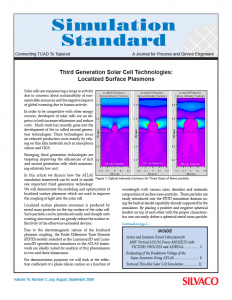Third Generation Solar Cell Technologies:
Localized Surface Plasmons
Solar cells are experiencing a surge in activity due to concerns about sustainability of non-renewable resources and the negative impacts of global warming due to human activity.
In order to be competitive with other energy sources, developers of solar cells see an impetus to both increase efficiencies and reduce costs. Much work has recently gone into the development of the so called second generation technologies. These technologies focus on reduced production costs mainly by relying on thin film materials such as amorphous silicon and CIGS.
Emerging third generation technologies are targeting improving the efficiencies of first and second generation cells while maintaining relatively low cost.
In this article we discuss how the ATLAS simulation framework can be used to model one important third generation technology. We will demonstrate the modeling and optimization of localized surface plasmons which are used to improve the coupling of light into the solar cell.



